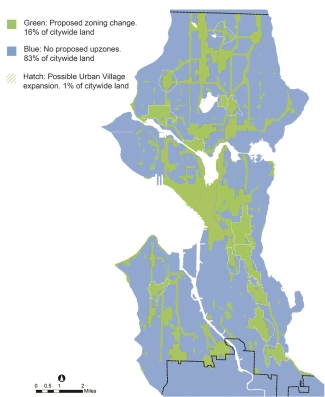|
Subscribe / Renew |
|
|
Contact Us |
|
| ► Subscribe to our Free Weekly Newsletter | |
| home | Welcome, sign in or click here to subscribe. | login |
Real Estate
| |
August 16, 2016
Council OKs new affordability rules and linkage fees
Journal staff reporter
The Seattle City Council on Monday unanimously approved Bill 118736, which adds to and amends portions of the municipal code affecting the development of new multifamily housing.
The bill is part of a framework known as Mandatory Housing Affordability for Residential Development, or MHA-R. Yesterday's vote follows last fall's similar measure that linked affordable housing to commercial development (MHA-C). Both are part of the city's broader Housing Affordability & Livability Agenda (HALA), that was launched in 2014 and last year resulted in the so-called “Grand Bargain” with developers.
The MHA-R bill passed out of committee on Aug. 2 with various amendments, some opposed by industry groups including the Coalition for Housing Solutions and Seattle Metropolitan Chamber of Commerce.
In its final form, the bill creates a regulatory framework for future housing affordability requirements. These include providing on-site units or paying linkage fees, using a sliding scale, to create the units elsewhere. Area median income, or AMI, will factor into the affordability formula, as will sunset provisions for rent caps — now 75 instead of 50 years.
The MHA-R bill won't go into effect until future multifamily upzoning is implemented in selected areas of the city — aka the Grand Bargain. The specifics of that upzoning still lie ahead on the council agenda — and are expected to raise opposition from many quarters.
Looking ahead to the effect upon multifamily developers, industry lobbyist Roger Valdez of Smart Growth Seattle said, “This is a disaster, and what I call a generational mistake. We've been opposed to it from the beginning. It's a one-size-fits-all sledgehammer approach to a problem, which is scarcity of housing.”
However, Valdez acknowledged, “The development community is not monolithic on this issue.” The Coalition for Housing Solutions anticipated Monday's vote with a conciliatory statement, which read in part, “It remains critical that the implementation ordinances anticipated in the months ahead maintain the principles and underlying economics of the Grand Bargain in order to achieve MHA's affordable housing production goals.”
Asked about the mandatory inclusive housing and/or linkage fees, Valdez said, “We're very, very skeptical.” Large downtown developers can live with MHA-C and MHA-R, he said, “because they get to pay a one-time fee, and they walk away, and they're done.” But speaking of smaller multifamily developers working north and south of downtown and South Lake Union, he said, “When you get this in the code, we're going to have to live with it forever.”
Valdez said he'd prefer to see more tax incentives like the Multifamily Property Tax Exemption (or MFTE), which he calls less costly and onerous to developers.
Championed by Mayor Ed Murray, HALA has a general goal of creating 20,000 affordable housing units, plus 30,000 market-rate units over 10 years. Funding would come from sources beyond commercial and multifamily linkage fees, including the recently passed Seattle Housing Levy.
The units would be located in areas presently deemed urban villages, along arterials, downtown and South Lake Union, and on land presently zoned commercial, mixed and multifamily.
HALA projections estimate about 16 percent of city land would be affected by upzoning. HALA further estimates that the city's population (now about 687,000) will grow 18 percent by 2035 (to over 800,000).
Brian Miller can be
reached by email at brian.miller@djc.com or by phone at (206) 219-6517.



